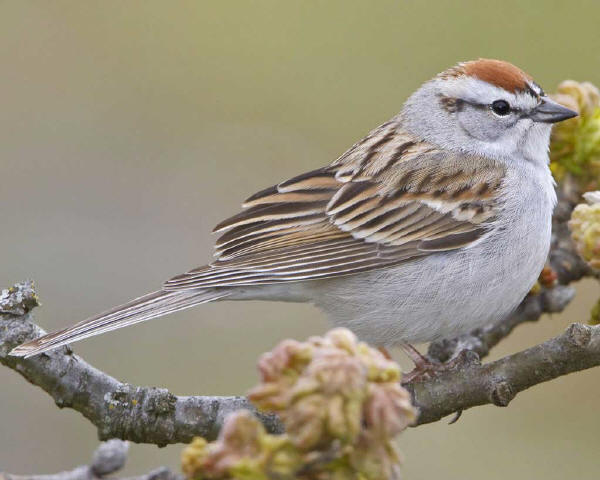 |
BIRD OF THE MONTH
OCTOBER 2015
CHIPPING sPARROW
(Spizella passerines)
 |
|
Our Bird of the Month is one of the most frequently encountered native sparrows. It may be found nesting along wooded edges, fence rows, and savannas, as well as our neighborhoods. Nesting wherever it is found during spring and summer, the Chipping Sparrow (Spizella passerines) is well known for its association not only in native habitats, but alsooliving right at our doorways. Early naturalist and ornithologist Alexander Wilson suggested its specific name should be …socialis, because of its close association with man. Noted New Englander and Massachusetts Ornithologist Edward H. Forbush wrote, “The Chipping Sparrow is the little brown-capped pensioner of the dooryard and lawn that comes about farmhouse doors to glean crumbs shaken from the table-cloth by thrifty housewives. It is the most domestic of all the sparrows. …and frequently builds its nest and rears its young in the clustering vines under the nose of the human tenants.” The Chipping is one of the “cleanest and neatest” of our sparrows. It has a rusty-cap, white supercilium, and black eye-line that continues to its lores. The back is a warm brown with dark streaks and the rump is grayish. Its throat is white, breast and under parts a clear gray, and the bill is small and conical in shape. During spring and summer, the adults are unmistakable; but when young are fledged, they are heavily streaked and do not resemble their parents until they acquire their first winter plumage. Then they both resemble each other with a brownish-rufous cap and tan/brownish supercilium. Both ages keep their black lores and gray rumps. During fall and winter, Brewer’s Sparrows (S. breweri) or Clay-colored Sparrows (S. pallida) may be confused with Chipping Sparrows and require careful study of face pattern and rump color before positive species identification is possible. Any Chipping Sparrow-like birds present during our winter need some close study – it might be one of the two similar looking sparrows, as “our” local Chipping have usually left Northern Illinois for warmer regions.
Breeding distribution of the Chipping Sparrows is extensive, ranging from nearly tree line in northern Alaska and Canada, south along both the Atlantic and Pacific coasts, and nearly country-wide. Only isolated areas in the Great Plains are without this species. They are partly migratory, with northern and central populations withdrawing to the Southeast, Gulf coast states, and Mexico.
Nesting habitats are varied, with Chipping Sparrows building their nests from
ground level to nearly 10 feet high. The nest is loose but neatly built
and the nests nay be lined with horse or other large animal’s hair when
available. They
frequently build their small nests in conifer trees and shrubs in our
neighborhoods. The first nests I found were in Junipers literally at my
front door.
On the Breeding Bird Atlas the Chipping Sparrow was found in all 102 of the counties and Vern Kleen, the Atlas author, suggested that it may nest in every township of the state. Almost every farmstead has Chipping nesting on it. If not found when surveying one of my Atlas blocks, stopping at a farmsteads and walking the road, I usually succeed in finding one chipping away on the top of an evergreen, phone, or electrical transmissions lines. Chipping Sparrow populations are healthy and increasing in the Midwest and East. However, population trends in the Appalachians , Northeast, and West are showing some slight decline as measured by the U.S. Geologic Service’s Breeding Bird Survey (BBS). The population index in Illinois has increased. Nationally, this sparrow's population seems stable to increasing.
Our Kane County Spring Bird Count (SBC) Index (birds/party hour – b/hr),
from the period of 1972 to 2014, has varied from year to year, but has
shown a steady increase from about 0.40 to 0.80 b/hr, a doubling of the
index.
-Bob Montgomery |
This page last updated Friday October 02, 2015.
Copyright 2006 - 2015 for all content of
www.kanecountyaudubon.org
Kane County Audubon, 513 S. 13th
Ave., St. Charles, IL 60174
Please report problems to
kca webmaster